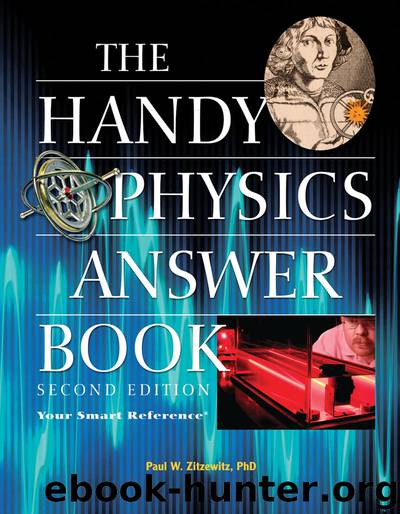The Handy Physics Answer Book by Paul W. Zitzewitz

Author:Paul W. Zitzewitz
Language: eng
Format: epub
Publisher: Visible Ink Press
Published: 2011-03-24T16:00:00+00:00
LIGHT
What is optics?
Optics is an area of study within physics that deals with the properties of and applications of light. Optics can be used not only with light, but with other parts of the electromagnetic spectrum, including microwaves, infrared, visible, ultraviolet, and X rays.
What were some early ideas about light?
Does light travel at a finite speed or is it infinite? Is light emitted by the eye or does it travel to the eye? These questions were debated for centuries. In ancient Greece, Aristotle (384–322 B.C.E.) argued that light is not a movement. Hero of Alexandria (10–70 C.E.) said it moves at infinite speed because you can see the stars and sun immediately after you open your eyes. Empedocles (490-430 B.C.E.) said it was something in motion, so it must move at a finite speed. Euclid (325–265 B.C.E.) and Ptolemy (90-168 C.E.) said that if we are to see something light must be emitted by the eye. In 1021 Alhazen (Ibn al-Haitham) did experiments that led him to support the argument that light moves from an object into the eye and thus it must travel at a finite speed. At the same time al-Biruni noted that the speed of light is much faster than the speed of sound. The Turkic astronomer Taqi al-Din (1521–1585) also argued that the speed of light was finite, and that its slower speed in denser objects explained refraction. He also developed a theory of color and correctly explained reflection.
In the 1600s the German astronomer Johannes Kepler (1571–1630) and the French philosopher, mathematician, and physicist René Descartes (1596–1650) argued that if the speed of light was not infinite, then the sun, moon, and Earth wouldn’t be in alignment in a lunar eclipse. Despite this misconception, Kepler, in his 1604 book, The Optical Part of Astronomy, essentially invented the field of optics. He described the inverse-square law, the workings of a pinhole camera, and reflection by flat and concave mirrors. He also recognized the influence of the atmosphere on both eclipses and the apparent locations of stars. Willibrord Snellius (1580-1626) discovered the law of refraction (Snell’s Law) in 1621. Descartes used Snell’s Law to explain the formation of rainbows shortly thereafter. Christiaan Huygens (1629–1695) wrote important books on optics and proposed the idea that light was a wave. Isaac Newton’s (1642-1727) celebrated experiments using a prism to separate white light into its colors led to Newton’s Theory of Colors published in 1672. He recognized that telescope lenses would cause colored images and invented the reflecting telescope using a concave mirror that would not have this fault. Newton believed that light was made up of very lightweight particles, or corpuscles.
In 1665, a publication by Francesco Grimaldi (1618–1663) described how light could be diffracted when passing through thin holes or slits or around boundaries. In 1803, Thomas Young’s (1773–1829) experiments with one and two slits demonstrated the diffraction and interference of light. Augustin-Jean Fresnel (1788–1827) and Simeáon Poisson (1781–1827) did both theoretical and experimental work that firmly established the wave theory of light in 1815 and 1818.
Download
This site does not store any files on its server. We only index and link to content provided by other sites. Please contact the content providers to delete copyright contents if any and email us, we'll remove relevant links or contents immediately.
The Complete Stick Figure Physics Tutorials by Allen Sarah(7336)
Secrets of Antigravity Propulsion: Tesla, UFOs, and Classified Aerospace Technology by Ph.D. Paul A. Laviolette(5332)
Thing Explainer by Randall Munroe(3909)
The River of Consciousness by Oliver Sacks(3572)
The Order of Time by Carlo Rovelli(3162)
How To by Randall Munroe(3074)
A Brief History of Time by Stephen Hawking(2991)
I Live in the Future & Here's How It Works by Nick Bilton(2959)
What If?: Serious Scientific Answers to Absurd Hypothetical Questions by Randall Munroe(2667)
The Great Unknown by Marcus du Sautoy(2662)
Midnight in Chernobyl by Adam Higginbotham(2515)
Blockchain: Ultimate Step By Step Guide To Understanding Blockchain Technology, Bitcoin Creation, and the future of Money (Novice to Expert) by Keizer Söze(2467)
Networks: An Introduction by Newman Mark(2382)
The Meaning of it All by Richard Feynman(2318)
Easy Electronics by Charles Platt(2308)
The Tao of Physics by Fritjof Capra(2247)
Midnight in Chernobyl: The Untold Story of the World's Greatest Nuclear Disaster by Adam Higginbotham(2195)
When by Daniel H Pink(2098)
Introducing Relativity by Bruce Bassett(2097)
